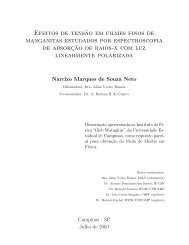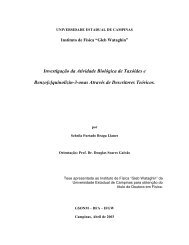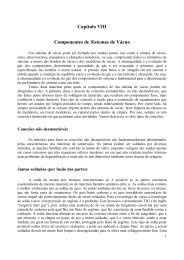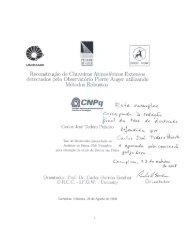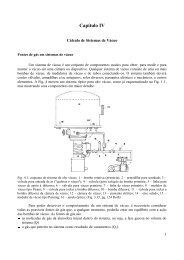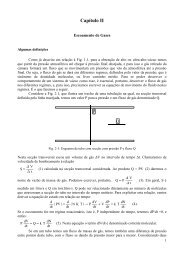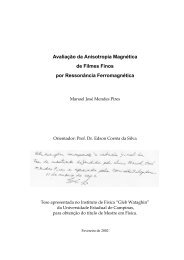Faça o download da tese completa na versão em PDF - A Biblioteca ...
Faça o download da tese completa na versão em PDF - A Biblioteca ...
Faça o download da tese completa na versão em PDF - A Biblioteca ...
You also want an ePaper? Increase the reach of your titles
YUMPU automatically turns print PDFs into web optimized ePapers that Google loves.
PHYSICAL REVIEW B 74, 193401 2006<br />
Transmission electron microscopy and molecular dy<strong>na</strong>mics study of the formation of<br />
suspended copper linear atomic chains<br />
F. Sato, 1 A. S. Moreira, 2 J. Bettini, 3 P. Z. Coura, 4 S. O. Dantas, 4, * D. Ugarte, 1,3,† and D. S. Galvão 1,‡<br />
1 Instituto de Física Gleb Wataghin, Universi<strong>da</strong>de Estadual de Campi<strong>na</strong>s, CP 6165, 13083-970 Campi<strong>na</strong>s, SP, Brazil<br />
2 Centro Brasileiro de Pesquisas Físicas, R. Dr. Xavier Sigaud 150, Rio de Janeiro, 22290-180, RJ, Brazil<br />
3 Laboratório Nacio<strong>na</strong>l de Luz Síncrotron, CP 6192, 13084-971 Campi<strong>na</strong>s, SP, Brazil<br />
4 Departamento de Física, ICE, Universi<strong>da</strong>de Federal de Juiz de Fora, 36036-330 Juiz de Fora, MG, Brazil<br />
Received 11 Sept<strong>em</strong>ber 2006; published 2 Nov<strong>em</strong>ber 2006<br />
We report high-resolution transmission electron microscopy and molecular dy<strong>na</strong>mics simulation results of<br />
mechanically stretching <strong>na</strong>nowires leading to linear atomic suspended chain LAC formation. In contrast with<br />
some previous experimental and theoretical works in the literature that stated that the formation of LAC’s for<br />
copper should be unlikely our results showed the existence of LAC’s for the 111, 110, and 100 crystallographic<br />
directions, being thus the sequence of most probable occurrence. Our results clearly indicate that<br />
t<strong>em</strong>perture and pulling velocity, associated with inter<strong>na</strong>l stress, are fun<strong>da</strong>mental aspects to determine LAC<br />
formation.<br />
DOI: 10.1103/PhysRevB.74.193401<br />
PACS numbers: 61.46.w, 62.25.g, 68.37.Lp<br />
In the last years an enormous amount of theoretical and<br />
experimental effort has been devoted to the study of <strong>na</strong>nostructures.<br />
Advances in experimental high-spatial-resolution<br />
techniques or microscopies high-resolution transmission<br />
electron microscopy HRTEM, scanning tunneling microscopy<br />
STM, and atomic force microscopy AFM have revealed<br />
new phenome<strong>na</strong> at the <strong>na</strong>noscale.<br />
Among <strong>na</strong>nostructures, metallic <strong>na</strong>nowires NW’s are of<br />
great interest due to the observation of very interesting<br />
physical phenome<strong>na</strong> spin filters, quantized conductance,<br />
etc. and their possible technological application in <strong>na</strong>nodevices<br />
molecular electronics, <strong>na</strong>nocontacts, etc.. 1–15 These<br />
structures have displayed quantized conductance of n 2e 2 /h<br />
G 0 , where n is an integer number, e is the electron charge,<br />
and h is Planck’s constant. 1 The ultimate NW’s are one atom<br />
thick, when suspended linear atomic chains LAC’s are<br />
formed.<br />
Most studies of LAC structures have been focused on Au,<br />
but in principle LAC’s may also be possible to exist for<br />
many other fcc metals Pt, Ag, Pd, etc., although we must<br />
<strong>em</strong>phasize that this issue is still rather controversial. 16–20<br />
From an experimental point of view, two techniques have<br />
been mostly used: mechanically controllable break<br />
junctions 15,21,22 MCBJ’s and in situ HRTEM. 3,5,23–25 The<br />
former is more appropriate for conductance experiments<br />
while the latter allows real-time visualization, providing a<br />
better evaluation of the dy<strong>na</strong>mical atomistic aspects of NW<br />
elongation. MCBJ experiments at low t<strong>em</strong>peratures have<br />
been carried out 17 for copper and the formation of LAC’s<br />
was not observed. Ab intio simulations, at zero Kelvin, also<br />
did not observe LAC’s. 16 Both experiments and simulations<br />
concluded that the existence of LAC’s at low t<strong>em</strong>peratures is<br />
very unlikely to occur.<br />
In this work we report HRTEM results of the study of<br />
mechanical stretching of copper NW’s for different crystallographic<br />
directions 111, 110, 100. In contrast with<br />
MCBJ results 17 we observed LAC formation for all the orientations<br />
investigated. These results are the first atomicresolved<br />
direct visualization observation of the existence of<br />
1098-0121/2006/7419/1934014<br />
39<br />
193401-1<br />
copper LAC’s. Molecular dy<strong>na</strong>mics simulations were also<br />
used to address and contrast the experimental results. By<br />
varying t<strong>em</strong>perature and intensity of stretching pulling velocity<br />
we can mimic the two different experimental regimes.<br />
Our results clearly indicated that t<strong>em</strong>perature and pulling<br />
velocity, associated with inter<strong>na</strong>l stress, play a fun<strong>da</strong>mental<br />
role in determining the required conditions to the LAC existence.<br />
Metallic NW’s were produced in situ in the HRTEM<br />
JEM-3010 URP 300 kV, 0.17 nm point resolution using<br />
the methodology proposed by Kondo and Takaya<strong>na</strong>gi. 26 Initially,<br />
holes are opened at several points in a self-supported<br />
metal film by focusing the microscope electron beam<br />
120 A/cm 2 Fig. 1a. When two holes become very<br />
close, <strong>na</strong>nometric constrictions bridges are formed between<br />
th<strong>em</strong> Fig. 1b. Then, the microscope beam current density<br />
is reduced to 10–30 A/cm 2 for image acquisition 18 and<br />
the <strong>na</strong>nowires evolve spontaneously, elongate Fig. 1c, and<br />
fi<strong>na</strong>lly break, sometimes with the formation of LAC’s Fig.<br />
2. In this range of beam current density the t<strong>em</strong>perature is<br />
estimated to be within 300–400 K. These processes are registered<br />
using a high-sensitive TV camera Gatan 622SC,<br />
30 frames/s and a stan<strong>da</strong>rd video recorder.<br />
The polycrystalline Cu thin films 10–30 nm in thickness<br />
were prepared by thermal evaporation of metal in a<br />
stan<strong>da</strong>rd vacuum evaporator 10 −7 mbar. A quartz crystal<br />
monitor was used to set the evaporation rate of the metal<br />
source and, subsequently, to measure the equivalent thickness<br />
of the film. To prevent oxi<strong>da</strong>tion the films were sandwiched<br />
between two 3-nm-thick amorphous carbon layers.<br />
Inside the microscope, the carbon layers are r<strong>em</strong>oved by<br />
electron irradiation. 18<br />
In Fig. 2, we present a typical HRTEM s<strong>na</strong>pshot showing<br />
a LAC composed by two atoms see also movie 01. 27 Due to<br />
the copper relative low atomic number and smaller lattice<br />
parameter, the HRTEM image contrast is rather weak; then,<br />
the observation of a high-contrast atomic resolution image is<br />
much more difficult to obtain than for other metals such as<br />
Au and Pt. 18<br />
©2006 The American Physical Society



